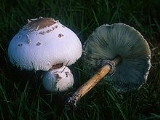
Chlorophyllum molybdites
Encyclopedia
Chlorophyllum molybdites, which has the common name
s of false parasol or green-spored parasol is a widespread mushroom. Highly poisonous and producing severe gastrointestinal symptoms of vomiting and diarrhea, it is commonly confused with the shaggy parasol
, and is the most commonly consumed poisonous mushroom in North America
. Its large imposing appearance and similarity to the edible Parasol mushroom, as well as its habit of growing in areas near human habitation, are reasons cited for this. The nature of the poisoning is predominantly gastrointestinal.
and Australia
.
(cap) up to 40 cm in diameter, hemispherical and with a flattened top. The cap is whitish in colour with coarse brownish scales. The gills are free and white, often with a greenish tinge. The tall stipe
may be up to 25 cm tall and bears a ring. This mushroom lacks the snakeskin pattern that is generally present on the parasol mushroom
. .
Common name
A common name of a taxon or organism is a name in general use within a community; it is often contrasted with the scientific name for the same organism...
s of false parasol or green-spored parasol is a widespread mushroom. Highly poisonous and producing severe gastrointestinal symptoms of vomiting and diarrhea, it is commonly confused with the shaggy parasol
Shaggy parasol
The Shaggy parasol is the common name for two closely related species of mushrooms, Chlorophyllum rhacodes and C. brunneum, found in North America and Europe .-Taxonomy:...
, and is the most commonly consumed poisonous mushroom in North America
North America
North America is a continent wholly within the Northern Hemisphere and almost wholly within the Western Hemisphere. It is also considered a northern subcontinent of the Americas...
. Its large imposing appearance and similarity to the edible Parasol mushroom, as well as its habit of growing in areas near human habitation, are reasons cited for this. The nature of the poisoning is predominantly gastrointestinal.
Distribution and habitat
Chlorophyllum molybdites grows in lawns and parks across eastern North America and California, and subtropical regions around the world. Fruiting bodies generally appear after summer and autumn rains. It has spread to other countries, with reports in ScotlandScotland
Scotland is a country that is part of the United Kingdom. Occupying the northern third of the island of Great Britain, it shares a border with England to the south and is bounded by the North Sea to the east, the Atlantic Ocean to the north and west, and the North Channel and Irish Sea to the...
and Australia
Australia
Australia , officially the Commonwealth of Australia, is a country in the Southern Hemisphere comprising the mainland of the Australian continent, the island of Tasmania, and numerous smaller islands in the Indian and Pacific Oceans. It is the world's sixth-largest country by total area...
.
Description
It is an imposing mushroom with a pileusPileus (mycology)
The pileus is the technical name for the cap, or cap-like part, of a basidiocarp or ascocarp that supports a spore-bearing surface, the hymenium. The hymenium may consist of lamellae, tubes, or teeth, on the underside of the pileus...
(cap) up to 40 cm in diameter, hemispherical and with a flattened top. The cap is whitish in colour with coarse brownish scales. The gills are free and white, often with a greenish tinge. The tall stipe
Stipe (mycology)
thumb|150px|right|Diagram of a [[basidiomycete]] stipe with an [[annulus |annulus]] and [[volva |volva]]In mycology a stipe refers to the stem or stalk-like feature supporting the cap of a mushroom. Like all tissues of the mushroom other than the hymenium, the stipe is composed of sterile hyphal...
may be up to 25 cm tall and bears a ring. This mushroom lacks the snakeskin pattern that is generally present on the parasol mushroom
Parasol mushroom
The parasol mushroom is a basidiomycete fungus with a large, prominent fruiting body resembling a lady's parasol. It is a fairly common species on well-drained soils. It is found solitary or in groups and fairy rings in pastures and occasionally in woodland...
. .

